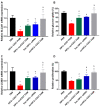CD70-Targeted Micelles Enhance HIF2α siRNA Delivery and Inhibit Oncogenic Functions in Patient-Derived Clear Cell Renal Carcinoma Cells
- PMID: 36500549
- PMCID: PMC9738223
- DOI: 10.3390/molecules27238457
CD70-Targeted Micelles Enhance HIF2α siRNA Delivery and Inhibit Oncogenic Functions in Patient-Derived Clear Cell Renal Carcinoma Cells
Abstract
The majority of clear cell renal cell carcinomas (ccRCCs) are characterized by mutations in the Von Hippel−Lindau (VHL) tumor suppressor gene, which leads to the stabilization and accumulation of the HIF2α transcription factor that upregulates key oncogenic pathways that promote glucose metabolism, cell cycle progression, angiogenesis, and cell migration. Although FDA-approved HIF2α inhibitors for treating VHL disease-related ccRCC are available, these therapies are associated with significant toxicities such as anemia and hypoxia. To improve ccRCC-specific drug delivery, peptide amphiphile micelles (PAMs) were synthesized incorporating peptides targeted to the CD70 marker expressed by ccRCs and anti-HIF2α siRNA, and the ability of HIF2α-CD27 PAMs to modulate HIF2α and its downstream targets was evaluated in human ccRCC patient-derived cells. Cell cultures were derived from eight human ccRCC tumors and the baseline mRNA expression of HIF2A and CD70, as well as the HIF2α target genes SLC2A1, CCND1, VEGFA, CXCR4, and CXCL12 were first determined. As expected, each gene was overexpressed by at least 63% of all samples compared to normal kidney proximal tubule cells. Upon incubation with HIF2α-CD27 PAMs, a 50% increase in ccRCC-binding was observed upon incorporation of a CD70-targeting peptide into the PAMs, and gel shift assays demonstrated the rapid release of siRNA (>80% in 1 h) under intracellular glutathione concentrations, which contributed to ~70% gene knockdown of HIF2α and its downstream genes. Further studies demonstrated that knockdown of the HIF2α target genes SLC2A1, CCND1, VEGFA, CXCR4, and CXCL12 led to inhibition of their oncogenic functions of glucose transport, cell proliferation, angiogenic factor release, and cell migration by 50−80%. Herein, the development of a nanotherapeutic strategy for ccRCC-specific siRNA delivery and its potential to interfere with key oncogenic pathways is presented.
Keywords: CD70; HIF2α; clear cell renal cell carcinoma; micelle; nanoparticle; siRNA.
Conflict of interest statement
BS is a consultant for Merck and Co. All other authors declare no conflict of interest.
Figures







Similar articles
-
Targeting HIF2α translation with Tempol in VHL-deficient clear cell renal cell carcinoma.Oncotarget. 2012 Nov;3(11):1472-82. doi: 10.18632/oncotarget.561. Oncotarget. 2012. PMID: 23178531 Free PMC article.
-
CYP1B1 promotes angiogenesis and sunitinib resistance in clear cell renal cell carcinoma via USP5-mediated HIF2α deubiquitination.Neoplasia. 2025 Aug;66:101186. doi: 10.1016/j.neo.2025.101186. Epub 2025 May 27. Neoplasia. 2025. PMID: 40435846 Free PMC article. Review.
-
The von Hippel-Lindau tumor suppressor protein regulates gene expression and tumor growth through histone demethylase JARID1C.Oncogene. 2012 Feb 9;31(6):776-86. doi: 10.1038/onc.2011.266. Epub 2011 Jul 4. Oncogene. 2012. PMID: 21725364 Free PMC article.
-
pVHL/HIF-regulated CD70 expression is associated with infiltration of CD27+ lymphocytes and increased serum levels of soluble CD27 in clear cell renal cell carcinoma.Clin Cancer Res. 2015 Feb 15;21(4):889-98. doi: 10.1158/1078-0432.CCR-14-1425. Clin Cancer Res. 2015. PMID: 25691774
-
Evolution of the HIF targeted therapy in clear cell renal cell carcinoma.Cancer Treat Rev. 2023 Dec;121:102645. doi: 10.1016/j.ctrv.2023.102645. Epub 2023 Oct 15. Cancer Treat Rev. 2023. PMID: 37879247 Review.
Cited by
-
Development and implementation of a prognostic model for clear cell renal cell carcinoma based on heterogeneous TLR4 expression.Heliyon. 2024 Feb 12;10(4):e25571. doi: 10.1016/j.heliyon.2024.e25571. eCollection 2024 Feb 29. Heliyon. 2024. PMID: 38380017 Free PMC article.
-
Advancements in understanding the molecular mechanisms and clinical implications of Von Hippel-Lindau syndrome: A comprehensive review.Transl Oncol. 2025 Jan;51:102193. doi: 10.1016/j.tranon.2024.102193. Epub 2024 Nov 21. Transl Oncol. 2025. PMID: 39571489 Free PMC article. Review.
References
-
- Wierzbicki P.M., Klacz J., Kotulak-Chrzaszcz A., Wronska A., Stanislawowski M., Rybarczyk A., Ludziejewska A., Kmiec Z., Matuszewski M. Prognostic significance of VHL, HIF1A, HIF2A, VEGFA and p53 expression in patients with clearcell renal cell carcinoma treated with sunitinib as firstline treatment. Int. J. Oncol. 2019;55:371–390. doi: 10.3892/ijo.2019.4830. - DOI - PMC - PubMed
-
- Dagher J., Kammerer-Jacquet S.F., Dugay F., Beaumont M., Lespagnol A., Cornevin L., Verhoest G., Bensalah K., Rioux-Leclercq N., Belaud-Rotureau M.A. Clear cell renal cell carcinoma: A comparative study of histological and chromosomal characteristics between primary tumors and their corresponding metastases. Virchows Arch. 2017;471:107–115. doi: 10.1007/s00428-017-2124-0. - DOI - PubMed
MeSH terms
Substances
Grants and funding
LinkOut - more resources
Full Text Sources
Medical
Research Materials
Miscellaneous

